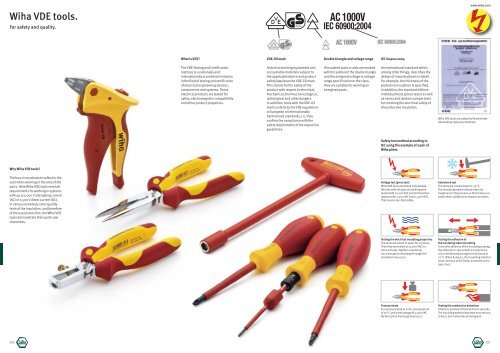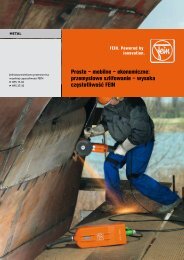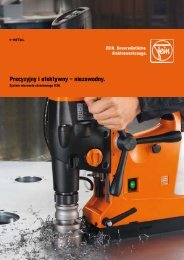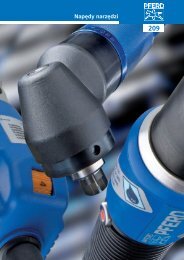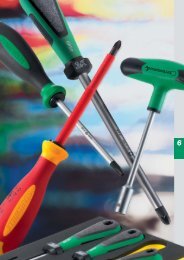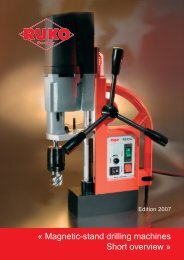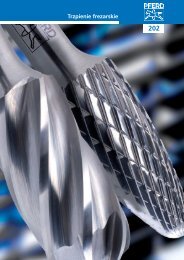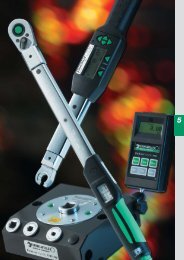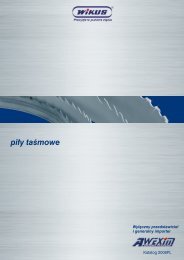Wiha VDE tools.
Wiha VDE tools.
Wiha VDE tools.
Create successful ePaper yourself
Turn your PDF publications into a flip-book with our unique Google optimized e-Paper software.
<strong>Wiha</strong> <strong>VDE</strong> <strong>tools</strong>.<br />
For safety and quality.<br />
www.wiha.com<br />
What is <strong>VDE</strong><br />
<strong>VDE</strong>-GS mark<br />
Double triangle and voltage range<br />
IEC 60900:2004<br />
The <strong>VDE</strong> Testing and Certification<br />
Institute is a nationally and<br />
internationally accredited institution<br />
in the field of testing and certification<br />
of electrical engineering devices,<br />
components and systems. These<br />
electrical products are tested for<br />
safety, electromagnetic compatibility<br />
and other product properties.<br />
Technical working equipment and<br />
consumable materials subject to<br />
the applicable device and product<br />
safety laws bear the <strong>VDE</strong>-GS mark.<br />
This stands for the safety of the<br />
product with respect to electrical,<br />
mechanical, thermal, toxicological,<br />
radiological and other dangers.<br />
In addition, <strong>tools</strong> with the <strong>VDE</strong>-GS<br />
mark conform to the <strong>VDE</strong> regulations<br />
or European or internationally<br />
harmonised standards, i.e. they<br />
confirm the compliance with the<br />
safety requirements of the respective<br />
guidelines.<br />
If insulated <strong>tools</strong> or aids are marked<br />
with the symbol of the double triangle<br />
and the assigned voltage or voltage<br />
range specification or the class,<br />
they are suitable for working on<br />
energised parts.<br />
An international standard which,<br />
among other things, describes the<br />
design of insulated <strong>tools</strong> in detail.<br />
For example, the thickness of the<br />
protective insulation is specified.<br />
In addition, the standard defines<br />
individual tests (piece tests) as well<br />
as series and random sample tests<br />
for checking the electrical safety of<br />
the protective insulation.<br />
<strong>Wiha</strong> <strong>VDE</strong> <strong>tools</strong> are subjected to extremely<br />
demanding safety test methods.<br />
Safety test method according to<br />
IEC using the example of a pair of<br />
<strong>Wiha</strong> pliers<br />
Why <strong>Wiha</strong> <strong>VDE</strong> <strong>tools</strong><br />
The focus is on absolute safety for the<br />
user when working in the area of life<br />
parts. Here <strong>Wiha</strong> <strong>VDE</strong> <strong>tools</strong> meet all<br />
requirements for working in systems<br />
with up to 1,000 V alternating current<br />
(AC) or 1,500 V direct current (DC).<br />
In various extremely strict quality<br />
tests of the insulation, and therefore<br />
of the user protection, the <strong>Wiha</strong> <strong>VDE</strong><br />
<strong>tools</strong> demonstrate their particular<br />
classiness.<br />
Voltage test (piece test)<br />
<strong>Wiha</strong> <strong>VDE</strong> <strong>tools</strong> are tested individually.<br />
All <strong>tools</strong> with the special marking were<br />
tested with 10,000 VAC and are therefore<br />
approved for 1,000 VAC (and 1,500 VDC).<br />
That means: ten-fold safety.<br />
Cold shock test<br />
The <strong>tools</strong> are cooled down to -25 °C.<br />
The insulating material must retain its<br />
toughness in the process so that it does not<br />
break when subjected to impacts and jolts.<br />
Testing the electrical insulating properties<br />
The <strong>tools</strong> are stored in water for 24 hours.<br />
Then they are tested at 10,000 VAC for<br />
three minutes. Neither a sparkover<br />
nor a disruptive discharge through the<br />
insulation may occur.<br />
Testing the adhesion of<br />
the insulating material coating<br />
To test the adhesion of the insulating coating,<br />
the adhesion is tested with a tensile force<br />
of 500 N following storage for 168 hours at<br />
70 °C. When doing so, the insulating material<br />
must continue to be firmly connected to the<br />
basic tool.<br />
Pressure tests<br />
At a pressure load of 20 N, a temperature<br />
of 70 °C and a test voltage of 5,000 VAC.<br />
No disruptive discharge may occur.<br />
Testing the combustion behaviour<br />
A flame is pointed at the tool for ten seconds.<br />
The insulating material may then not continue<br />
to burn, but instead must extinguish.<br />
226<br />
227


